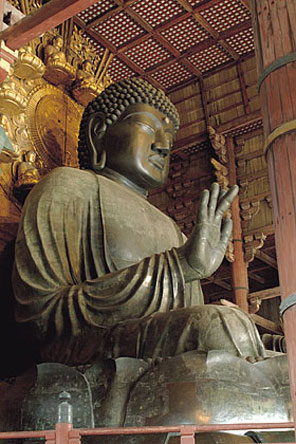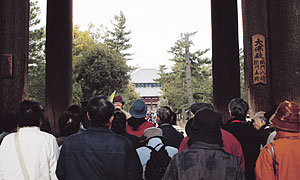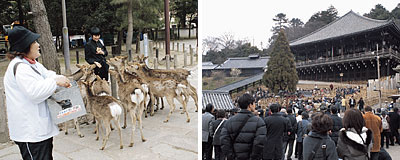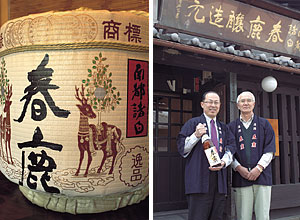Japan Travelogue NARA
I left Nara-machi and headed through nearby Nara Park to the northeast. Glancing at the deer taking it easy in the park, I walked to the start of the pilgrims' lane leading straight to the Great Buddha Hall of Todai-ji Temple. The lane presented a confusing mixture of souvenir shops, groups of deer, students on school trips, people participating in group tours, and foreign tourists.
On the pilgrim's lane I heard, “Shika senbei aru yo~!” (“Come get crackers for the deer here!”), and ended up buying crackers made from rice bran and wheat flour. Right away, I was surrounded by more than a dozen deer, all waiting for a generous guy like me. The deer crackers were gone in a minute.
After gazing in awe at the Great Buddha, I went off into the dusk, pushed along by a crowd all heading up to Nigatsudo Hall. The temple grounds offer a good view of the city below. The area was packed with tourists, all come to see the flaming torches of Omizutori, a Buddhist rite that has been practiced here for more than 1,200 years. The tradition was apparently started by monks carrying torches to light their way to a religious event at Nigatsudo.
Dusk turned to night, and suddenly all of the electric lights illuminating the big hall went out. The chatter of the crowd quickly changed to an expectant hush. A temple bell broke the silence, and on this signal monks with flaming torches ran up a long ramp to the big hall. The darkness was no more, and the crowd let out a collective gasp.
Huge flames from the torches held high scorched the night air. Sparks fell in a fiery cascade, then faded away in the cold. What was left turned to a snowy ash, drifted up, then fell silently upon us.
The magical event ended quietly in less than 20 minutes, but the scene is still branded into my memory. ![]()


Left: The Great Buddha (height, about 15 meters). The temple hall was burned twice during civil disturbances and the statue was badly damaged, but each time they were returned to their former splendor. The present Great Buddha dates from the end of the 17th century.
Above: Participants in a group tour listen carefully to their guide in front of the Nandai Gate at Todai-ji Temple. The Great Buddha Hall waits for them in the background.


Left: A barrel of saké brewed by Imanishi Seibe'e Shoten. The saké goes by the name of Harushika and is sought after by many in Japan and abroad.
Right: The Imanishi Family has been brewing saké for Kasuga Taisha Shrine since around the 10th century. Imanishi Kiyotaka (holding a bottle of Harushika saké) is the family's 48th generation brewer. With him is master brewer Furukawa Takeshi.
